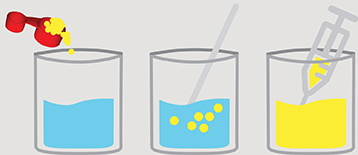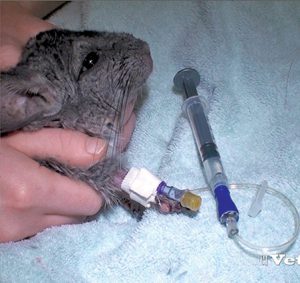Feeding Instructions for Carnivore Care and Critical Care
Step 1: Weigh Patient
 Best done at the beginning of each morning before they have eaten, been medicated or had fluids given, (or on admission).
Best done at the beginning of each morning before they have eaten, been medicated or had fluids given, (or on admission).
Step 3: Address Hypothermia
 Maintain patient in ICU with environmental support as needed.
Maintain patient in ICU with environmental support as needed.
- Oxygen
- Heat
- Lighting
Step 4:Determine Appropriate Emeraid or Emeraid Combination
The EmerAid System for Exotic Animal Critical Care is designed for three main nutritional strategies: EmerAid Herbivore, EmerAid Omnivore, and EmerAid Carnivore. The EmerAid Carnivore diet meets the nutritional needs of both carnivores and insectivores. Feed EmerAid products singly or in combination to best meet the needs of your specific patient.
Click to see mixing table (Search for specific species.)
Step 5A: Determine MLS/Feeding for Mammals and Birds
- When feeding CRITICALLY ILL ANIMALS, begin with a smaller food volume.
- 1st feed 1% body weight, 2nd feed 2% body weight, 3rd feed 3% body weight.
- Volumes fed are only increased if well tolerated and passed through the gastrointestinal tract.
Feeding volumes for mammals and birds based on percent body (or %BW)
Step 5B: Determine mls/feeding for reptiles
- When feeding CRITICALLY ILL ANIMALS, begin with a smaller food volume.
- 1st feed 0.5 % body weight, 2nd feed 1% body weight, 3rd feed 2% body weight.
- Volumes fed are only increased if well tolerated and passed through the gastrointestinal tract.
Feeding volumes for reptiles based on percent body (or %BW)
Step 6: Mix enough EmerAid for feeding
- Measure out EmerAid according to Step 4 "Parts" indicate the proportions needed. To mix EmerAid, you can use the scoop provided, a syringe cap, or any measuring implement of your choice as long as the proportions described above remain consistent.
- Add powder to hot water measuring 50°C (122°F).
- Mix well.
- Use a syringe to draw up the mixture. When made as directed, EmerAid formula can pass through both an 18-gauge feeding needle and a 5 French feeding tube.
- Make fresh for each feeding. Discard remaining food after each feeding.
Standard mixing directions for the EmerAid System for Exotic Critical Care
Helpful Hint
EmerAid mixture can be placed in a shake tube or capped pill vial for mixing. Mix thoroughly to avoid any clumps or potential blocks during administration.
Step 7: Determine frequency of feeding
The decision on how frequently to feed must rely on clinical judgment as FREQUENCY depends on the species, the individual and their ability to handle the stress of restraint, the patient's clinical response, and the underlying clinical problem.
- Is the patient gaining or losing weight?
- Has the patient vomited or regurgitated?
- Has normal faecal production been observed?
Recommended frequency of feeding
Step 8: Administration of EmerAid by syringe or gavage
- Monitor patients closely. Administer all other treatments BEFORE gavaging to prevent regurgitation.
- Immediately after gavaging, please place patient gently back in cage or incubator.
- See LafeberVet, for restraint and administration techniques.
Step 9: On-going fluid requirements
 Calculate daily fluid requirements and correct for dehydration needs over 2-3 days.
Calculate daily fluid requirements and correct for dehydration needs over 2-3 days.
On-going fluid requirements
Step 10: Next day – weigh patient first

- Important to weigh before first gavage feeding so weight accurately reflects patient weight.
- Consider possible increased weight due to slow stomach/crop or GI emptying.
- Am I meeting my patient's ENERGY REQUIREMENTS?
Step 11: Re-assess patient
- If the patient is in very poor condition, or has lost weight, increase frequency or volume of feeding.
- For more detailed calculations refer to: Lafeber.com/vet/emergency-medicine/
Repeat Steps 5-11: Begin feeding assessment cycle again.
Medicine is both science and art. While these instructions may work, many patients have conflicting aspects that must be considered when using these guidelines. Patient considerations include maximum volume tolerated, patient stress, general neuro-muscular/skeletal weakness, speed of GI motility, hydration status, temperature and critical weight loss.
Disclaimer:
These simplified instructions are based on the patient being dehydrated on admission and the patient physiologically accepting suggested feeding volumes and frequency. They are intended only as a guideline and must be adjusted with the patient assessment of the attending veterinarian.
Source: https://emeraid.com/vet/emeraid-intensive-care-basic-use-guide/
0 Response to "Feeding Instructions for Carnivore Care and Critical Care"
Post a Comment